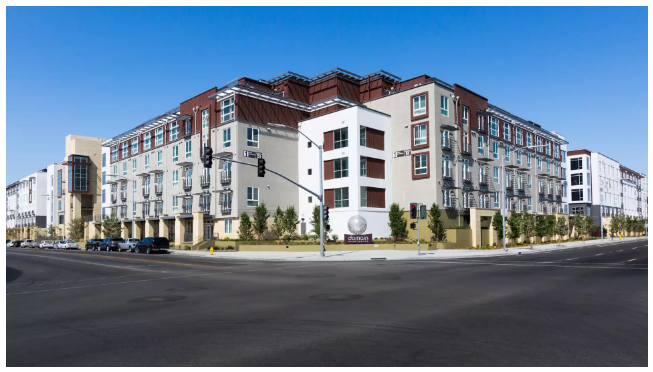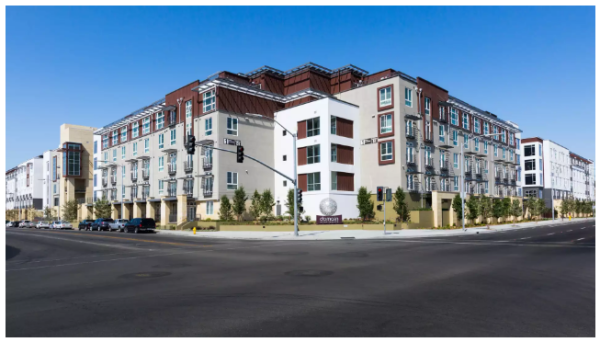
Domain Apartments 1/3
Structures: Domain part of mod, mod world
Residential Project Winner
The new Domain Apartments complex made a long journey out West before settling on its final foundation in North San Jose. The 444 units were prefabricated in Idaho and hauled by trucks to the construction site at 1 Vista Montana, where a crane lowered them to their permanent location over a 700-car parking garage. Almost all the units will be two- or three-story townhouse-style apartments in five buildings.
Domain Apartments (formally called Vista Montana) is among the largest modular complex of this kind in the Bay Area, according to Eli Barton, project engineer at Palisade Builders Inc., a division of Douglas Ross Construction that developer Equity Group Residential tapped to build the project. Modular builder Guerdon Enterprises LLC of Boise, Idaho, constructed the units and remains responsible for building the site’s exterior and foundation.
“There’s been plenty of other modular projects but this one is very different,” said project manager Jason Anderlite of Douglas Ross Construction. “It’s (one of the) first projects done over a parking podium that we know of. Most other modular projects have been built on grade, with no parking underneath.”
He said this type of design is much more complicated.
“You can’t just make holes anywhere, everything has to be perfect because of the modular units. It has to be dead on,” he added.
Modular buildings are defined as sectional, prefabricated buildings or houses that consist of multiple sections called modules. The modules are actually boxes that are made in a remote facility, then delivered to the project site. The modules are set onto a foundation by a crane and joined to make a single building.
Modular Means Faster
Peter Solar, Equity Residential development director, said the decision to build modularly was made largely because it would mean having product on the market quicker.
“It’s a faster construction process,” Solar said. “We’ve probably saved about nine months of construction, and right now that’s particularly important because of demand.”
Anderlite agrees.
“What would take 12 months to build traditionally, takes 9 ½ months with modular construction,” he said. The largest building in the project, which is 133 units, will take about 25 days to stack.
For Solar, it’s more than just a matter of time.
“The quality you get on the field is much better because the units are built out of a factory where there is better quality control,” he said. “Plus, you don’t have to worry about weather damage, such as rain warping wood.”
Each of the 15-foot-wide, 70-foot-long units were 100 percent completed down to the finishes when they arrived at the construction site last June. This means there’s less disruption to neighbors because less construction is performed on the 7-acre site, Solar added.
It’s also about 5 percent to 10 percent less expensive to build modularly, but that wasn’t the developer’s main motivation, he said. The contract for on-site construction was $105 million, according to Ross Construction’s website.
Although Equity Residential got approvals to build the project in 2008, the developer decided to wait out the downturn. Then demand started to pick up again, and the city offered the incentive of removing affordable housing fees.
Site preparation work began in September 2011 and construction will be conducted in phases. The complex, which also includes a 700-car parking garage and a clubhouse, is expected to be completed by November 2013. The units will be one, two and three bedrooms and more than 200 of them will have 700-square-foot private roof decks.

